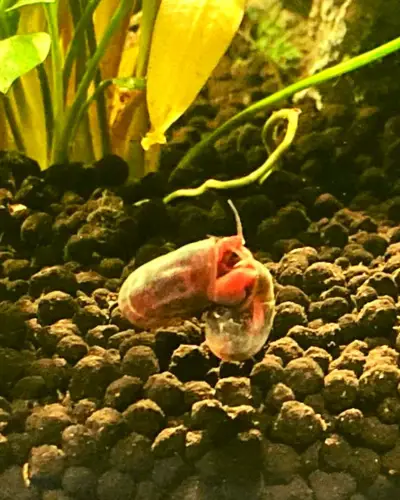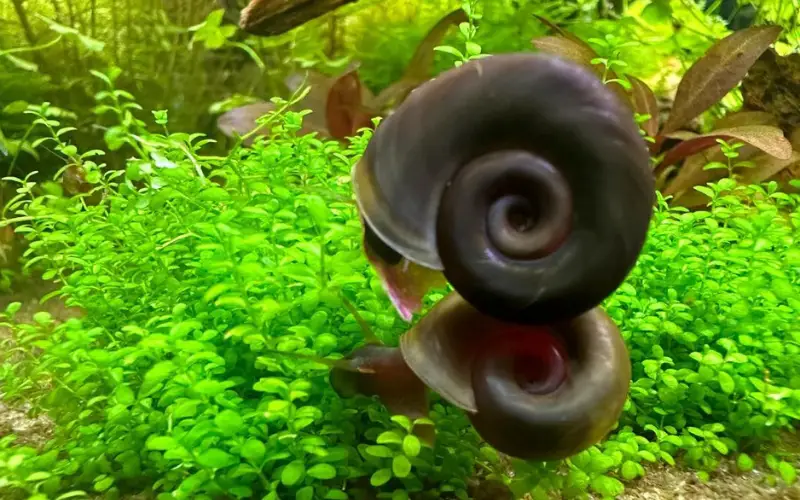The Giant Ramshorn Snail, scientifically known as Marisa Cornuarietis, is a fascinating and striking aquatic snail species that has become increasingly popular among aquarium enthusiasts.
With its unique cone-shaped shell and vibrant colors, the Marisa Cornuarietis is visually appealing and serves a valuable ecological purpose in freshwater ecosystems.
In this ultimate guide, we will explore everything you need to know about caring for and maintaining these beautiful creatures in your own aquarium.

From their natural habitat to their behavior, diet, and optimal tank conditions, we will delve into all aspects of keeping Colombian ramshorn snails happy and healthy.
Whether you are a seasoned aquarium hobbyist or a beginner looking to add a unique touch to your underwater world, this comprehensive guide will provide all the information you need to care for Marisa Cornuarietis successfully.
So sit back, relax, and immerse yourself in the beautiful world of the Columbian ramshorn snail.
Table of Contents
ToggleColombian Giant Ramshorn Snail Aquarium
Giant Ramshorn snail Marisa cornuarietis is a type of freshwater snail that belongs to the family Ampullariidae. These aquatic creatures are known for their gelatinous appearance and can grow up to 50 mm in size.
Marisa cornuarietis, commonly called the Giant Columbian Ramshorn Snail, is an invasive species from Central America. They can be found in various countries, such as Colombia, Venezuela, Costa Rica, and Panama.

These omnivorous snails feed on vegetation, including aquatic plants, and can reproduce quickly, leading to potential ecological problems. They are also known to compete with native snails for resources.
The juvenile snails of the Marisa snail are striped and have a gill that allows them to breathe underwater. As the young snails grow, they develop a calcium-based shell that resembles a ram’s horn, hence their name.
These large snails lay their eggs on hard surfaces above the waterline, and the eggs hatch into small juveniles. The Ramshorn Snail is a nonindigenous species and has been listed in the USGS Nonindigenous Aquatic Species Database.
Note: In environments characterized by lower calcium concentrations and softer water, Ramshorn snails are notably vulnerable to shell deterioration.
Distribution and Natural Habitat of Marisa Cornuarietis Snails
The Marisa Cornuarietis snail, also known as the Giant Ramshorn, has a widespread distribution across two main areas:
Native range:
- Northern South America and Central America, including Bolivia, Brazil, Colombia, Costa Rica, Cuba, French Guiana, Guyana, Panama, Suriname, Trinidad and Tobago, and Venezuela.
- They are believed to be native to the Magdalena and Orinoco river systems in Colombia and Venezuela.
Introduced range:
- Established populations exist outside their native range in several locations, including:
- Caribbean nations: Cuba, Puerto Rico (Cowie and Hayes 2011), Martinique, Guadeloupe, Dominican Republic.
- Southern USA: Florida, Texas, California, and Idaho.
- Africa: Sudan and Tanzania.
- Spain
- Introductions were likely accidental, mainly through the aquarium trade and cargo vessels.
Natural Habitat
The Marisa Cornuarietis snail thrives in freshwater habitats with abundant vegetation. They are typically found in:
- Slow-moving and shallow waters (up to 1 meter deep)
- Lakes, rivers, ponds, irrigation systems, and swamps
- Areas with dense aquatic plants
- They can tolerate slightly brackish water (up to 4 parts per thousand salinity).
These snails play a role in their natural ecosystem as detritivores, consuming decaying organic matter and algae, which helps maintain water quality. However, they can become invasive in areas outside their native range, where they can compete with native species for resources and disrupt the ecological balance.
The Difference Between the Giant Colombian Ramshorn snail and the Giant Ramshorn Snail
The Giant Colombian Ramshorn Snail and the Giant Ramshorns are the same species, scientifically known as Marisa cornuarietis. They are relatively large snails native to northern South America and several Caribbean islands.
There is some confusion surrounding the name because “Giant Ram horn Snail” is a common name for this species. At the same time, “Giant Colombian Ramshorn Snail” is a more specific, descriptive term that highlights its origin. But both names refer to the same snail.
These snails are popular in the aquarium trade due to their:
- Large size: They can grow up to 2 inches (5 cm) in shell diameter, making them impressive additions to freshwater tanks.
- Algae eating habits: They help control algae growth in aquariums.
- Peaceful nature: They are generally friendly towards other tank inhabitants, making them suitable for community tanks.
However, it’s important to note that they can also be:
- Prolific breeders can reproduce quickly, potentially leading to overpopulation in aquariums.
- Destructive to plants: While primarily eating algae, they can consume and damage live plants, especially soft-leaved varieties.
If you’re considering adding Giant Colombian Ramshorn Snails to your aquarium, carefully research their care requirements and choose tank mates that won’t prey on them.
Breeding Giant Ramshorn Snails
Breeding Colombian Giant Ramshorn Snails can be a fascinating hobby for those interested in invertebrates. These relatively giant snails, also known as the great ramshorn, can be found in the continental United States.
A widespread species within the apple snail family, they are not to be confused with the Colombian ramshorn apple snail, which can carry diseases like schistosomiasis.
The giant rams-horn snail is a freshwater snail, Gastropoda, prosobranchia, and is often used in research studies such as the ones conducted by Howells et al. in BMC Evolutionary Biology.
The eggs are laid in large gelatinous masses on aquatic vegetation when breeding. The eggs are visible as small dots but swell up to 4 mm. If you are lucky enough to see the snail laying eggs, you may also know the snail moving around in its natural habitat.
It is essential to monitor the breeding process closely to ensure the health and well-being of these fascinating creatures.
Commonly Asked Questions about Freshwater Colombian Giant Ramshorn Snail (FAQs)
How big do giant ramshorn snails get?
Giant Colombian ramshorn snails can grow up to 2 inches (5 cm) in diameter, making them the largest freshwater snail species commonly kept in aquariums.
Do giant Ramshorn snails eat other snails?
Yes, Columbian ramshorn snails are known to eat other snails. They are considered omnivorous scavengers and can consume small snails as part of their diet.
Are Ramshorn snails aggressive?
No, Ramshorn snails are not considered aggressive. They are peaceful creatures and usually pose no harm to other tank inhabitants. They are more focused on scavenging for food and algae, making them a beneficial addition to aquariums.
Are Ramshorn snails rare?
No, Ramshorn snails are not considered rare. They are widely distributed and commonly found in freshwater environments such as ponds, aquariums, and slow-moving rivers. Their adaptability and ability to reproduce quickly contribute to their abundance in many regions.
What is the rare color Ramshorn snail?
While some Ramshorn snail colors are less common than others, like black or deep pink, rarity can depend on specific location and breeder practices.
Where are ramshorn snails found?
Ramshorn snails thrive in freshwater habitats like ponds, lakes, slow rivers, and aquariums. They can be found globally in most temperate climates.
What do giant ramshorn snails eat?
Giant ramshorns are omnivores, enjoying a varied diet, including most aquatic plants and regular fish food. While helpful as algae eaters, they can also munch on your prized aquarium plants, so consider their appetite before adding them.
Do ramshorn snails fight?
Ramshorn snails are peaceful and lack the means to fight. They cannot harm other tank mates and might climb on each other for non-aggressive reasons like mating or exploring.
Do ramshorn snails have a siphon?
No, ramshorn snails do not have a breathing siphon. Unlike other aquatic snails, ramshorn snails rely on their gills to extract oxygen from the water.
Conclusion
In conclusion, the world beneath the water’s surface holds captivating wonders waiting to be discovered. From the vibrant coral reefs to the ocean’s mysterious depths, every creature has its unique story to tell. Among these fascinating inhabitants is the Colombian ramshorn snail, which epitomizes resilience and adaptability. Its spiral shell, reminiscent of a tiny work of art, conceals a remarkable journey of survival against all odds.
Exploring the intricate ecosystems where these snails thrive opens our eyes to the delicate balance of nature and the importance of preserving it. So, next time you find yourself by a riverbank or a tranquil pond, take a moment to appreciate the hidden beauty of the Giant Ramshorn Snail and the intricate web of life it represents.
You might also like
- Are Ramshorn Snails Invasive: (Shocking Truth Revealed!)
- Ramshorn Snail Lifespan 101: A Complete Caring Guide
- How Big Do Ramshorn Snails Get in Aquariums (Answered)
- Ramshorn Snail Size 101: Expert Aquatic Snails Caring Guide
- Do Ramshorn Snails Eat Plants in Aquarium: (Myths & Facts)
- Ramshorn Snail Pond 101: The Key Player in the Water Ecosystem
- What Do Giant African Land Snails Like to Eat: (African Snail Care Sheet)





